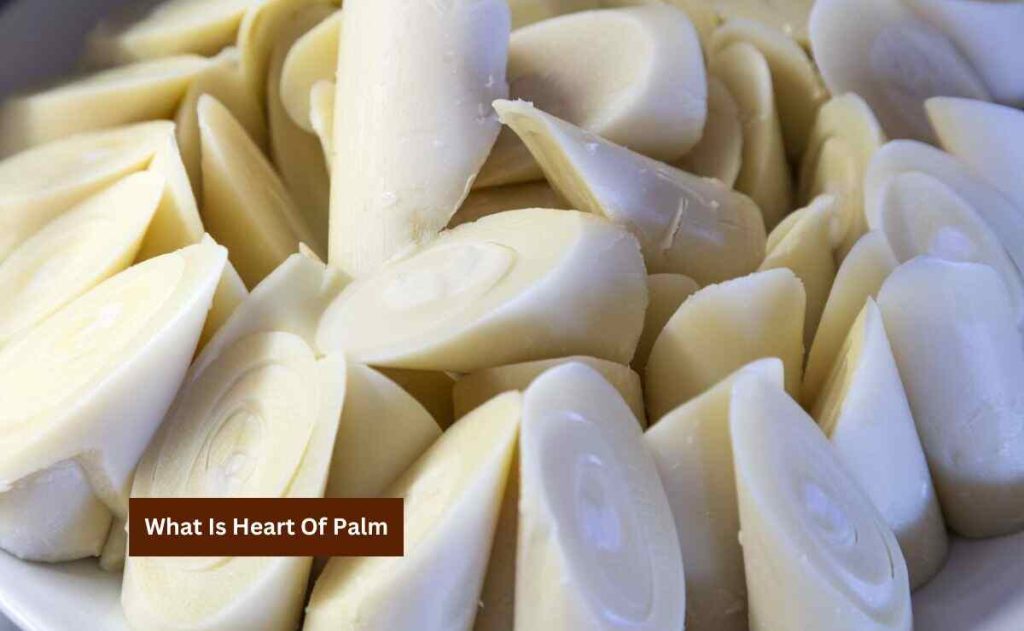A vegetable harvested from the core of certain palm trees is called heart of palm. It’s commonly used in salads and various dishes. It boasts high nutritional values. No doubt, the veggie is excellent for humans but can dogs eat heart of palm?
Thankfully, dogs can eat the heart of palm. It is safe for your buddy. There are no toxins or harmful elements that can call for medical emergencies in canines. Like other plant-based foods, this veggie is beneficial for your dogs.
What Is Heart Of Palm?

Heart of palm is a vegetable from the Araceae family. It’s a conical vegetable that can grow up to 20 inches. It’s basically harvested from the center of the trunk of palm trees.
The heart of palm is native to tropical regions like Central and South Africa. However, people also cultivate it widely in Latin America.
This vegetable has a nutty and light taste with crunchy textures. It reminds me of artichokes. Furthermore, it’s a versatile vegetable and can be used in salads, soups, stir-fries, and goes well with rice dishes.
Nutritional Value of Hearts of Palm
The vegetable is low in fat content and contains essential minerals, vitamins, and antioxidants. It can be a guard against various chronic diseases.
A 100-gram raw heart of palm contains
| Minerals | Amount |
| Calories | 36 |
| Fat | less than 1 gram |
| Protein | 4 grams |
| Carbs | 4 grams |
| Fiber | 4 grams |
| Zinc | 36% of the DV |
| Copper | 70% of the DV |
| Potassium | 38% of the Daily Value (DV) |
| Phosphorus | 20% of the DV |
Can Dogs Eat Heart Of Palm?

As we have already told, dogs can eat heart of palm. There’s no evidence that suggests it is harmful to dogs.
Heart of palm is something you might not think about unless you’re a gardener or someone who spends time with plants. However, palm trees grow in many places, from tropical spots like Florida and Hawaii to even cooler areas like New England. While people might recognize palm trees, not everyone realizes that the fruit that grows on them is called “heart of palm.”
Now, this fruit isn’t harmful to humans, but it contains something called saponins, which can upset the stomach in some animals. Luckily, most dogs don’t seem to be affected by saponins because they lack the enzymes needed to break down these compounds. In fact, the Food and Drug Administration considers heart of palm as safe for humans.
Still, there isn’t a lot of detailed information about how it affects dogs, so it’s always a smart move to consult your vet before adding heart of palm to your pup’s diet. If your vet says it’s okay, you can go ahead and let your dog give it a try.
If you’re curious and want to see how your dog reacts to it, you can offer them a tiny piece to taste. Just remember to keep it away from puppies under six months old, and if there are any spills, clean them up promptly.
What Are the Benefits of Palm Hearts for Dogs?
Eating heart of palm has some potential benefits for dogs. For example,
1. Good source of fiber
Heart of palm is rich in fiber, which is fantastic for regulating digestion. If your dog occasionally has trouble with bowel movements or needs to maintain a healthy weight, this vegetable is quite helpful. It can prevent constipation and support a healthy gut microbiome, which is crucial for overall digestive health.
2. Essential Minerals
This veggie is packed with important minerals that support your dog’s overall health. These include potassium, calcium, zinc, phosphorus, copper, and magnesium. Also, it contains vitamin B6, which plays a role in maintaining healthy blood circulation in dogs.
Moreover, copper is found in heart of palm that plays a vital role in forming red blood cells. It enhances blood circulation and delivers oxygen and nutrients throughout the body. Additionally, copper aids in maintaining nerve cells, the immune system, blood pressure, and cholesterol levels.
3. Low in Calories and Fat
If your dog needs to shed a few pounds, heart of palm can be a tasty option. It’s low in both fat and carbs, making it a smart choice for a treat. The fiber in heart of palm helps your dog feel full for longer, reducing the urge to overeat. This can help prevent unhealthy weight gain.
4. Promote Muscle Development
Surprisingly, heart of palm is also rich in protein, which is crucial for tissue repair and growth in your dog’s body. It can also help control weight by keeping your dog satisfied after meals.
5. Low in Sugar
Excessive sugar is unhealthy for dogs just like it is for humans. Thankfully, heart of palm is low in sugar, so you don’t have to worry about diabetes or obesity when incorporating it into their diet.
6. Guard Against Chronic Diseases
Heart of palm is packed with antioxidants, including polyphenols, which can protect cells from oxidative damage. This can reduce the risk of chronic diseases like diabetes, cancer, and heart disease.
Are Hearts of Palm Bad for Dogs?
Though there are a lot of benefits of the heart of palm, there are possible downsides and risks associated with feeding this unique vegetable.
Gastric Irritation: Heart of palm is not a typical part of a dog’s diet. So it can lead to stomach irritation. They may have symptoms like vomiting, diarrhea, dehydration, flatulence, and abdominal discomfort. The extent of these symptoms depends on your dog’s tolerance and the quantity consumed.
Allergic Reactions: While many dogs might enjoy the taste of palm hearts, it can trigger allergies in them. Allergic reactions can manifest as gastrointestinal issues, irritability, pacing, a high heart rate, and hard breathing.
Pathogen Contamination: Like other raw vegetables, palm hearts can carry bacterial and parasitic contaminants, such as C. botulinum spores. While a dog’s digestive system can combat these organisms to some extent, excessive ingestion can lead to gastroenteritis or food poisoning.
Asphyxiation Risk: Raw palm hearts can pose a choking hazard for dogs, given their smaller throats. Signs of potential asphyxiation include dilated pupils, excessive salivation, and a persistent cough.
Excessive Fiber: While fiber is good for digestion, too much can result in gastrointestinal issues like diarrhea, bloating, and gas. Introduce heart of palm gradually and in moderation.
How to Feed Hearts of Palm to Dogs?
When feeding the heart of palm to your dog, it’s important to prepare it properly. So here are some ways to feed them:
- Fresh, Raw, or Cooked
You can present the vegetables in different ways as your dog likes. You can offer them fresh or cooked, depending on what your dog enjoys. If you opt for serving them raw, remember to give the vegetables a thorough wash to remove any dirt or debris. However, when cooking, it’s crucial to skip the spices or seasonings, as these can be harmful to your pet’s health.
- Wash Thoroughly
Before feeding hearts of palm to your dog, you need to wash them thoroughly. Rinse them under cold water or soak them in a bowl of water for a few minutes. This step ensures that your dog enjoys clean and safe food.
- Chop or Dice into Smaller Pieces
To make hearts of palm easier for your dog to digest and chew, consider chopping or dicing them into smaller, manageable pieces. This is not only helpful in digestion but also reduces the risk of choking or intestinal blockage. Be sure to remove any tough or fibrous parts before offering them to your dog.
- Incorporate into Treats or Meals
Hearts of palm can be a versatile addition to your dog’s diet. You can mix them into your dog’s regular meals or include them as a healthy treat. They can be blended with kibble or integrated into homemade dog food recipes. They also work well as a standalone snack.
How Often Should You Give Your Dog Hearts of Palm?
When it comes to hearts of palm, think of it as a special treat for your furry friend. While it is a delightful addition to their diet, it should not replace their regular dog food. It doesn’t provide all the essential components needed for a balanced canine diet.
If you’d like, you can include a small portion of this tasty vegetable with each of your dog’s meals. This adds a touch of variety and nutrition to their diet without becoming their primary food source. Offering a small piece as a treat can motivate and reward your dog for their good behavior or during training sessions.
Conclusion
If you are giving heart of palm to your puppy for the first time, it’s recommended to introduce it gradually. Initially, give your dog a small amount and watch for any adverse reactions such as diarrhea or vomiting.
If your dog experiences any of these symptoms, stop giving the vegetable. Dogs can eat the veggie as long as it is given in moderation and prepared properly. Before making any changes to your dog’s diet, consider their individual dietary needs and consult your veterinarian.
Related Posts
